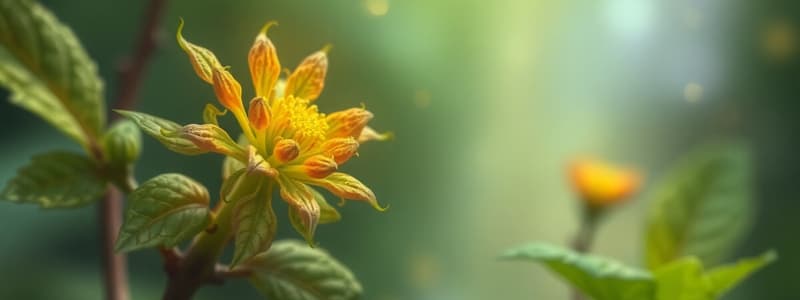Podcast
Questions and Answers
Plant secondary metabolites primarily participate in plant growth and development.
Plant secondary metabolites primarily participate in plant growth and development.
False (B)
Approximately 100,000 structures of plant secondary metabolites have been discovered.
Approximately 100,000 structures of plant secondary metabolites have been discovered.
True (A)
Terpenoids are a major group of plant secondary metabolites with more than 25,000 compounds.
Terpenoids are a major group of plant secondary metabolites with more than 25,000 compounds.
True (A)
Alkaloids and cyanogenic glycosides are examples of chemical defense compounds produced by plants.
Alkaloids and cyanogenic glycosides are examples of chemical defense compounds produced by plants.
Mechanical defense strategies include substances like thorns and a thick epidermis.
Mechanical defense strategies include substances like thorns and a thick epidermis.
Slimes are characterized as alkaloids and are primarily produced by mature plants.
Slimes are characterized as alkaloids and are primarily produced by mature plants.
The concentration of plant secondary metabolites remains constant throughout plant development.
The concentration of plant secondary metabolites remains constant throughout plant development.
Biosynthesis of plant secondary metabolites primarily occurs in the mitochondria.
Biosynthesis of plant secondary metabolites primarily occurs in the mitochondria.
Glycosides consist of a sugar moiety linked to a non-sugar moiety.
Glycosides consist of a sugar moiety linked to a non-sugar moiety.
Terpenoids can only be synthesized through the Mevalonate Pathway.
Terpenoids can only be synthesized through the Mevalonate Pathway.
Phenolic compounds can be derived from amino acids.
Phenolic compounds can be derived from amino acids.
Alkaloids are exclusively derived from terpenoids.
Alkaloids are exclusively derived from terpenoids.
Saponins are categorized under terpenoids and may have applications as phytosterols.
Saponins are categorized under terpenoids and may have applications as phytosterols.
Cyanogenic glycosides are known to release HCN upon hydrolysis.
Cyanogenic glycosides are known to release HCN upon hydrolysis.
Phenolic compounds lack any anti-inflammatory properties.
Phenolic compounds lack any anti-inflammatory properties.
The acetate-malonate pathway is the primary route for phenolic compound formation.
The acetate-malonate pathway is the primary route for phenolic compound formation.
Tannins are derived from glycosides.
Tannins are derived from glycosides.
True alkaloids do not include compounds derived from amino acids.
True alkaloids do not include compounds derived from amino acids.
Flashcards
Plant Secondary Metabolites (PSM)
Plant Secondary Metabolites (PSM)
Organic compounds made by plants that aren't directly involved in growth, but have important roles in survival and evolution.
Defensive Role of PSM
Defensive Role of PSM
Primarily act as defense mechanisms against herbivores, pathogens, or competitors.
Chemical Defense Compounds
Chemical Defense Compounds
Chemicals produced by plants that help deter herbivores or pathogens.
Alkaloids
Alkaloids
Signup and view all the flashcards
Phenols
Phenols
Signup and view all the flashcards
Terpenoids
Terpenoids
Signup and view all the flashcards
Ontogenetic Changes in PSM Concentration
Ontogenetic Changes in PSM Concentration
Signup and view all the flashcards
Seasonal Changes in PSM Concentration
Seasonal Changes in PSM Concentration
Signup and view all the flashcards
Glycosides
Glycosides
Signup and view all the flashcards
O-glycosidic bond
O-glycosidic bond
Signup and view all the flashcards
S-glycosidic bond
S-glycosidic bond
Signup and view all the flashcards
C-glycosidic bond
C-glycosidic bond
Signup and view all the flashcards
Simple Phenol Glycoside
Simple Phenol Glycoside
Signup and view all the flashcards
Cyanogenic Glycoside
Cyanogenic Glycoside
Signup and view all the flashcards
Steroidal Glycoside
Steroidal Glycoside
Signup and view all the flashcards
Anthraquinone Glycoside
Anthraquinone Glycoside
Signup and view all the flashcards
Terpenoids (Isoprenoids)
Terpenoids (Isoprenoids)
Signup and view all the flashcards
Mevalonate Pathway
Mevalonate Pathway
Signup and view all the flashcards
Study Notes
Plant Secondary Metabolites (PSM)
- PSM are complex organic compounds produced by plants in small quantities.
- Approximately 100,000 known structures have been identified, but only a small percentage (5-15%) of plant structures have been chemically studied.
- They play a vital role in plant survival and evolution.
- Unlike primary metabolites, which are directly involved in growth and development, PSMs indirectly support plant survival.
Defensive Role of PSM
- PSMs play crucial defensive roles through:
- Mechanical defenses: Thorns, trichomes, thick epidermis, and sticky/smooth surfaces make the plant less desirable to herbivores.
- Chemical defenses: Alkaloids, phenols, terpenoids, iridoid glycosides, cardenolides, and cyanogenic glycosides act as toxic substances deterring herbivores.
Biosynthesis of PSM
- PSMs are synthesized from precursor molecules, including amino acids (for alkaloids), activated isoprenes, and shikimic acid.
- Biosynthetic pathways primarily occur within the cytoplasm, plastids, endoplasmic reticulum, and mitochondria.
- Enzyme diversity and genetic variations allow for multiple compounds to potentially be synthesized from one enzyme or pathway.
Classification of PSM
- PSMs are categorized into major groups based on structure and function:
- Terpenoids/Isoprenoids (>25,000 compounds): Synthesized from isoprene units via mevalonate or methylerythritol phosphate pathways. Examples include essential oils, bitters, saponins, and carotenoids.
- Phenylpropanoids (~2,000 compounds): Derived from amino acids, primarily through the shikimate-chorismate pathway. Examples include tannins and lignin, which play a role in plant structure and defense.
- Alkaloids (~12,000 compounds): Nitrogen-containing compounds synthesized from amino acids. Diverse functions, including affecting the nervous system. Examples include nicotine and morphine.
Temporal Changes in PSM
- PSM concentrations can change throughout the plant's lifespan (ontogenetic changes) and seasonally (seasonal changes).
- Factors influencing seasonal changes include temperature, light, water availability, and nutrient conditions.
Small Group 1: Slimes (Mucilaginous Substances)
- Mucilaginous substances are polysaccharides with a high water retention capacity, swelling into colloidal solutions or gels.
- They have various applications, for example, protecting the mucosa in inflammatory diseases (GIT, throat) and as lubricants (emollients), laxatives, and antidiarrheal agents.
- Examples include marshmallow root, mallow flower, and flaxseed.
Small Group 2: Glycosides
- Glycosides are compounds featuring a sugar linked to a non-sugar moiety (aglycone).
- Different types of glycosides are formed with various linkages, like the O-glycosidic, S-glycosidic, and C-glycosidic bonds.
- They display a wide spectrum of therapeutic functions varying with the aglycone structure, including diuretic, cardiotonic, and anti-inflammatory properties.
- Examples include salicin (from willow bark), arbutin, cyanogenic glycosides (HCN release), cardiac glycosides (e.g., digitoxin), and anthraquinone glycosides (laxatives).
Large Group 1: Terpenoids (Isoprenoids)
- Terpenoids are derived from isoprene units via synthesis pathways.
- Their structure contains numerous conjugated double bonds, making them susceptible to oxidation.
- Key roles include antioxidant activity, defense against herbivores/pathogens (e.g. carotenoids, lycopene, saponins, e.g., licorice root).
Large Group 2: Phenolics
- Phenolic compounds are aromatic metabolites with hydroxyl groups attached to aromatic rings.
- Common biosynthesis pathways are shikimate-chorismate (from amino acids) and acetate-malonate pathways (polyketides).
- Types range from simple phenols, to phenols with additional carbons, to those with multiple rings (like xanthones, stilbenes, and flavonoids).
- Phenolics display properties including but not limited to strengthening capillary walls, reducing vein permeability, and exhibiting anti-inflammatory and diuretic effects.
- Tannins, a related group, are categorized as hydrolyzable (from simple phenols) or condensed (from flavonoids).
Large Group 3: Alkaloids
- Alkaloids are nitrogen-containing compounds derived from amino acids.
- Subtypes include "true" alkaloids (derived from amino acids), protoalkaloids (amino acid derivatives), and pseudoalkaloids (derived from terpenoids or polyketides).
- They noticeably affect the nervous system, serving as stimulants, sedatives, or spasmolytics.
- Examples include morphine, nicotine, and caffeine.
Practical Applications
- PSMs have potential medicinal applications, including treating chronic diseases, serving as a complement to synthetic medicines, and potentially reducing side effects.
- They exhibit diverse therapeutic potentials.
Studying That Suits You
Use AI to generate personalized quizzes and flashcards to suit your learning preferences.




